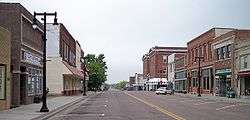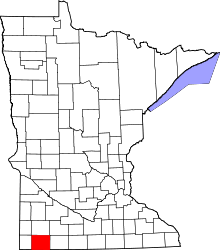Worthington, Minnesota
| Worthington, Minnesota | |
|---|---|
| City | |
|
Tenth Street in downtown Worthington in 2007 | |
| Motto: You'll Come To Love Us | |
 Location of the city of Worthington within Nobles County in the state of Minnesota | |
| Coordinates: 43°37′26″N 95°35′57″W / 43.62389°N 95.59917°W | |
| Country | United States |
| State | Minnesota |
| County | Nobles |
| Government | |
| • Type | Mayor - Council |
| • Mayor | Mike Kuhle |
| Area[1] | |
| • Total | 8.74 sq mi (22.64 km2) |
| • Land | 7.34 sq mi (19.01 km2) |
| • Water | 1.40 sq mi (3.63 km2) |
| Elevation | 1,591 ft (485 m) |
| Population (2010)[2] | |
| • Total | 12,764 |
| • Estimate (2015[3]) | 13,090 |
| • Density | 1,739.0/sq mi (671.4/km2) |
| Time zone | Central (CST) (UTC-6) |
| • Summer (DST) | CDT (UTC-5) |
| ZIP code | 56187 |
| Area code(s) | 507 |
| FIPS code | 27-71734[4] |
| GNIS feature ID | 0654391[5] |
| Website | City Website |
Worthington is a city and county seat of Nobles County, Minnesota, United States. The population was 12,764 at the 2010 census.[6]
The city's site was first settled in the 1870s as Okabena Station on a line of the Chicago, St. Paul, Minneapolis and Omaha Railway, later the Chicago and North Western Railway (now part of the Union Pacific Railroad) where steam engines would take on water from adjacent Lake Okabena. More people entered along with one A.P. Miller of Toledo, Ohio, under a firm called the National Colony Organization. Miller named the new city after his wife's maiden name.
History
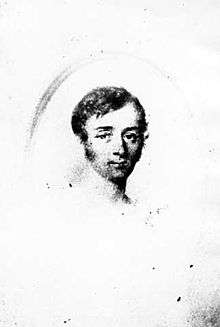
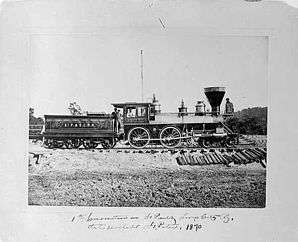
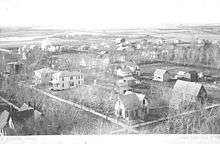
The first European likely to have visited the Nobles County area of southwestern Minnesota was French explorer Joseph Nicollet. Nicollet mapped the area between the Mississippi and Missouri Rivers in the 1830s. He called the region “Sisseton Country” in honor of the Sisseton band of Dakota Indians then living there. It was a rolling sea of wide open prairie grass that extended as far as the eye could see. One small lake in Sisseton Country was given the name “Lake Okabena” on Nicollet’s map, “Okabena” being a Dakota word meaning “nesting place of the herons.”[7]
The town of Worthington was founded by "Yankees" (immigrants from New England and upstate New York who were descended from the English Puritans who settled New England in the 1600s).[8]
In 1871, the St. Paul & Sioux City Railway Company began connecting its two namesake cities with a rail line. The steam engines of that time required a large quantity of water, resulting in water stations being needed every eight to twelve miles (19 km) along their routes. One of these stations, at the site of present-day Worthington, was designated as “The Okabena Railway Station.”
Meanwhile, in that same year, Professor Ransom Humiston of Cleveland, Ohio, and Dr. A.P. Miller, editor of the Toledo Blade, organized a company to locate a colony of New England settlers who had already settled in Northern Ohio along the tracks of the Sioux City and St. Paul Railway. These were people were "Yankee" settlers whose parents had moved to the region of Northeast Ohio known as the Connecticut Western Reserve from the six New England states. These settlers were primarily members of the Congregational Church, though due to the Second Great Awakening, many of them had converted to Methodism and Presbyterianism, and some had become Baptists before coming to what is now Minnesota. This colony – the National Colony – was to be a village of temperance, a place where evangelical Methodists, Presbyterians, Congregationalists, and Baptists could live free of the temptations of alcohol. A town was plotted, and the name was changed from the Okabena Railway Station to Worthington - Worthington being the maiden name of Dr. Miller’s mother-in-law.[9] On April 29, 1872, regular passenger train service to Worthington was started, and on that very first train were the first of the National Colony settlers. One early arrival described the scene:
We were among the first members of the colony to arrive at the station of an unfinished railroad… There was a good hotel, well and comfortably furnished, one or two stores neatly furnished and already stocked with goods, [and] several other[s] in process of erection… The streets, scarcely to be defined as such, were full of prairie schooners, containing families waiting until masters could suit themselves with “claims,” the women pursuing their housewifely avocations meanwhile – some having cooking stoves in their wagons, others using gypsy fires to do their culinary work; all seeming happy and hopeful.[10]
Some settlers from New England were however, drinking men, most of whom were civil war veterans from Massachusetts and Maine, who came in to conflict with the temperance movement.[11] A curious event took place on Worthington’s very first Fourth of July celebration. Hearing that there was a keg of beer in the Worthington House Hotel, Professor Humiston entered the hotel, seized the keg, dragged it outside, and destroyed it with an axe. A witness described what happened next:
''Upon seeing this, the young men of the town thought it to be rather an imposition, and collected together, procured the services of the band, and under the direction of a military officer marched to the rear of the hotel, and with a wheelbarrow and shovel took the empty keg that had been broken open, and playing the dead march with flag at half staff marched to the flagpole in front of Humiston’s office where they dug a grave and gave the empty keg a burial with all the honors attending a soldier’s funeral.
They then, with flag at full mast and with lively air, marched back to the ice house, procured a full keg of beer, returning to the grave, resting the keg thereon. Then a general invitation was given to all who desired to partake, which many did until the keg was emptied… In the evening they reassembled, burning Prof. Humiston in effigy about 10 p.m. Thus ended the glorious Fourth at Worthington, Minn. —Sibley Gazette July 5, 1872[12]
In spite of tensions between pro-temperance and anti-temperance factions, the town grew rapidly. By the end of summer in 1872, eighty-five buildings had been constructed where just one year before there had been nothing but a field of prairie grass.
Settlers poured into the region. At first they came almost exclusively from the six New England states due to issues of overpopulation combined with land shortages, which led to a stream of "Yankee" immigrants leaving that region. Some had come from Upstate New York and had parents and grandparents who had moved to that region from New England during the early 1800s and late 1700s. Due to the large number of New Englanders and New England transplants from upstate New York the town of Worthington, like much of Minnesota at this time, was very culturally continuous with early New England culture for much of its early history.[8] It was the age of the Homestead Act when 160 acres (0.65 km2) of government land could be claimed for free. All one had to do was live on the land and “improve” it, a vague phrase if ever there was one. In such an atmosphere, settlers without connection to the National Colony also arrived in great number, and few of those were temperance activists. The ensuing winter was a severe one, and swarms of grasshoppers stripped farmers’ fields bare in the summer of 1873. Still, settlers came. 1874 produced a bumper harvest, followed by another grasshopper invasion in 1875. 1876 and 1877 were both good farming years. Grasshoppers returned for the last time in 1879, and a bright future began for southwestern Minnesota. According to the 1880 census, Nobles County boasted 4435 residents, 636 of them living in Worthington.
In the early 1900s German immigrants began arriving in Worthington in large numbers, though this later group did not come directly from Germany, but rather (mostly) came to Worthington from other places in the midwest, especially the state of Ohio, where their communities had already been established.[13]
Unlike other parts of the country, the Germans were not subjected to xenophobia in Nobles County, Minnesota but rather were welcomed with open arms by the "Yankee" population who had established the town. This led to many writing back to Ohio, which led to chain migration to the region which greatly increased the German-American population.[13] The "Yankee" population of old stock Americans of English descent did not come into conflict with the German-American community for much of their early history together in what is now Worthington. However eventually the two communities would be divided on the issue of World War I in which the Yankee community would be divided and the Germans were unanimously opposed to American entry into the war. The Yankee community was generally pro-British, however many of the Yankees also did not want America to enter the war themselves. The Germans were sympathetic to Germany and did not want the United States to enter into a war against Germany, but the Germans were not anti-British. Prior to World War I, many German community leaders in Minnesota and Wisconsin spoke openly and enthusiastically about how much better America was than Germany, due primarily (in their eyes) to the presence of English law and the English political culture the Americans had inherited from the colonial era, which they contrasted with the turmoil and oppression in Germany which they had so recently fled.[14] Other immigrant groups followed the Germans including setters from Ireland, Norway and Sweden. For German, Irish and Scandinavian immigrants seeking a new life, southwestern Minnesota was a new world.
On December 12, 2006 the Immigration and Customs Enforcement (I.C.E) staged a coordinated predawn raid at the Swift & Company meat packing plant in Worthington and at five other Swift plants in western states, interviewing workers and hauling hundreds off in buses.[15][16][17]
Geography
According to the United States Census Bureau, the city has a total area of 8.74 square miles (22.64 km2), of which 7.34 square miles (19.01 km2) is land and 1.40 square miles (3.63 km2) is water.[1]
Demographics
| Historical population | |||
|---|---|---|---|
| Census | Pop. | %± | |
| 1880 | 636 | — | |
| 1890 | 1,164 | 83.0% | |
| 1900 | 2,386 | 105.0% | |
| 1910 | 2,385 | 0.0% | |
| 1920 | 3,481 | 46.0% | |
| 1930 | 3,878 | 11.4% | |
| 1940 | 5,918 | 52.6% | |
| 1950 | 7,923 | 33.9% | |
| 1960 | 9,015 | 13.8% | |
| 1970 | 9,916 | 10.0% | |
| 1980 | 10,243 | 3.3% | |
| 1990 | 9,977 | −2.6% | |
| 2000 | 11,283 | 13.1% | |
| 2010 | 12,764 | 13.1% | |
| Est. 2015 | 13,090 | [3] | 2.6% |
The U.S. Bureau of Census now classifies Worthington as one of its micropolitan areas. Population of the Worthington Micropolitan Area is 20,508.
2010 census
As of the census[2] of 2010, there were 12,764 people, 4,458 households, and 2,917 families residing in the city. The population density was 1,739.0 inhabitants per square mile (671.4/km2). There were 4,699 housing units at an average density of 640.2 per square mile (247.2/km2). The racial makeup of the city was 62.2% White, 5.5% African American, 0.7% Native American, 8.6% Asian, 0.1% Pacific Islander, 20.5% from other races, and 2.4% from two or more races. Hispanic or Latino of any race were 35.4% of the population.
There were 4,458 households of which 34.7% had children under the age of 18 living with them, 48.4% were married couples living together, 10.7% had a female householder with no husband present, 6.3% had a male householder with no wife present, and 34.6% were non-families. 28.4% of all households were made up of individuals and 13.9% had someone living alone who was 65 years of age or older. The average household size was 2.79 and the average family size was 3.36.
The median age in the city was 33.5 years. 26.8% of residents were under the age of 18; 10.7% were between the ages of 18 and 24; 26.1% were from 25 to 44; 21.3% were from 45 to 64; and 15% were 65 years of age or older. The gender makeup of the city was 51.1% male and 48.9% female.
2000 census
As of the census[4] of 2000, there were 11,283 people, 4,311 households, and 2,828 families residing in the city. The population density was 1,578.9 people per square mile (609.3/km²). There were 4,573 housing units at an average density of 639.9 per square mile (246.9/km²). The racial makeup of the city was 76.81% White, 1.91% African American, 0.49% Native American, 7.06% Asian, 0.13% Pacific Islander, 11.49% from other races, and 2.11% from two or more races. Hispanic or Latino of any race were 19.28% of the population.
There were 4,311 households out of which 30.5% had children under the age of 18 living with them, 52.4% were married couples living together, 8.9% had a female householder with no husband present, and 34.4% were non-families. 28.9% of all households were made up of individuals and 15.5% had someone living alone who was 65 years of age or older. The average household size was 2.55 and the average family size was 3.12.
In the city the population was spread out with 25.5% under the age of 18, 9.7% from 18 to 24, 27.1% from 25 to 44, 20.1% from 45 to 64, and 17.6% who were 65 years of age or older. The median age was 36 years. For every 100 females there were 98.6 males. For every 100 females age 18 and over, there were 97.6 males.
The median income for a household in the city was $36,250, and the median income for a family was $44,643. Males had a median income of $28,750 versus $20,880 for females. The per capita income for the city was $18,078. About 9.1% of families and 13.3% of the population were below the poverty line, including 18.4% of those under age 18 and 12.3% of those age 65 or over.
Government
Worthington is located in Minnesota's 1st congressional district, represented by Tim Walz, a Democrat. At the state level, Worthington is located in Senate District 22, represented by Republican Bill Weber, and in House District 22B, represented by Republican Rod Hamilton.[19]
Local politics
The mayor of Worthington is Mike Kuhle. City council members meet in City Hall weekly to discuss current objectives and goals for the city.
There is a sister-city relationship between Worthington and Crailsheim, Germany.[20]
Education
Worthington is served by Independent School District 518.
- High School: Worthington High School
- Middle School: Worthington Middle School
- Elementary School: Prairie Elementary School
Technical College: Minnesota West Community and Technical College
Transportation
- Highways
 Interstate 90
Interstate 90 U.S. Route 59
U.S. Route 59 Minnesota State Highway 60
Minnesota State Highway 60 Minnesota State Highway 266 (decommissioned - designated as Nobles County Road 25)
Minnesota State Highway 266 (decommissioned - designated as Nobles County Road 25).svg.png) Nobles County Road 25
Nobles County Road 25.svg.png) Nobles County Road 35
Nobles County Road 35
Notable people
- Wendell Butcher, American football player
- George Dayton, a banker and real estate developer in Worthington before moving to Minneapolis to start Dayton's Department Store (now part of Macy's). Recently restored, the 1890 Dayton House is a community historic site and bed and breakfast.
- Matt Entenza, former minority leader of the Minnesota House of Representatives (2002–2006) and a 2010 DFL candidate for governor of Minnesota. He grew up in Worthington and attended Worthington public schools.
- Big Tiny Little, pianist and television personality.
- Stephen Miller, fourth governor of Minnesota from 1864–1866, later settled in Worthington, representing the area in the Minnesota House of Representatives from 1873-1874. He was an 1876 presidential elector. Upon his death in 1881, he was buried in Worthington Cemetery.
- Lee Nystrom, NFL player, was born in Worthington.
- Tim O'Brien, an American novelist known for his Vietnam War literature, grew up in Worthington in the 1950s. He references Worthington in several of his novels, including driving around Lake Okabena in The Things They Carried, published in 1990.
- Mary Beth Blegen National Teacher of the Year, 1996
- John Olson, longtime state senator and Worthington native, represented southwestern Minnesota from 1959–1977. He chaired the Minnesota Senate's General Legislation Committee from 1967–1971, and the Higher Education Committee from 1971-1973.
Local Events
Worthington hosts many yearly events: Windsurfing Regatta & Music Festival (June), International Festival (July), King Turkey Day (September), and Holiday Parade (November).
Newspaper
The newspaper for Worthington and surrounding areas is the Daily Globe. (www.dglobe.com)
References
- 1 2 "US Gazetteer files 2010". United States Census Bureau. Retrieved 2012-11-13.
- 1 2 "American FactFinder". United States Census Bureau. Retrieved 2012-11-13.
- 1 2 "Annual Estimates of the Resident Population for Incorporated Places: April 1, 2010 to July 1, 2015". U.S. Census Bureau. Retrieved July 2, 2016.
- 1 2 "American FactFinder". United States Census Bureau. Retrieved 2008-01-31.
- ↑ "US Board on Geographic Names". United States Geological Survey. 2007-10-25. Retrieved 2008-01-31.
- ↑ "2010 Census Redistricting Data (Public Law 94-171) Summary File". American FactFinder. United States Census Bureau. Retrieved 27 April 2011.
- ↑ https://books.google.com/books?id=8AMwAAAAYAAJ A.P. Rose's History of Nobles County pp. 34-35
- 1 2 The expansion of New England: the spread of New England settlement and institutions to the Mississippi River, 1620-1865 page 247
- ↑ Worthington album : A project of the Worthington Daily Globe by Crippen, Raymond. Heritage House Publishers, 1998.
- ↑ https://books.google.com/books?id=8AMwAAAAYAAJ A.P. Rose's History of Nobles County
- ↑ Nobles County - Minnesota Historical Records Survey Project - The Project - 1939
- ↑ From New Cloth : The making of Worthington By Hudson, Lew. Published by American Legion Post #5, Worthington, MN 1976,
- 1 2 Nobles County History by Al Goff - Nobles County Historical Society, Minnesota - 1958
- ↑ The German Historians and England: A Study in Nineteenth-century Views By Charles E. McClelland pages 19, 136, 138. 176, 196
- ↑ "U.S. Raids 6 Meat Plants in ID Case", article New York Times by Julia Preston, December 13, 2006
- ↑ "Series of Immigration Raids Hits Identity-Theft Ring", article NPR by Pam Fessler, December 13, 2006
- ↑ "Worthington shaken after ICE raid", article Star Tribune by Richard Meryhew, December 14, 2006
- ↑ "Census of Population and Housing". Census.gov. Retrieved July 2, 2016.
- ↑ "Who Represents Me?". Legislative Coordinating Commission - Geospatial Information. LCC-GIS Office. Retrieved February 2, 2016.
- ↑ "Worthington, Minnesota". Sister Cities International. Archived from the original on June 23, 2015. Retrieved June 23, 2015.
External links
| Wikimedia Commons has media related to Worthington, Minnesota. |
- City of Worthington
- Community Web Site of Worthington, Minnesota
- Historic Dayton House
- Worthington Daily Globe newspaper site
- Worthington Windsurfing Regatta and Unvarnished Music Festival
